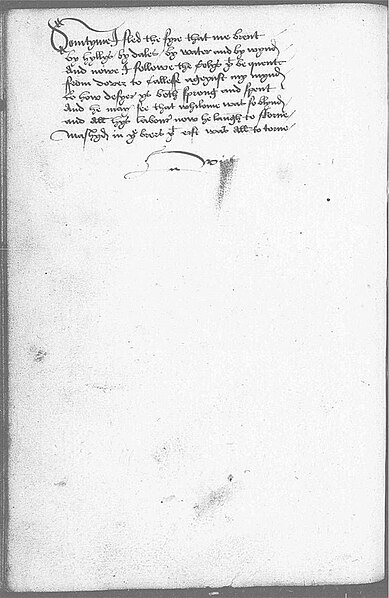The Devonshire Manuscript/Somtyme I fled the fyre that me brent /
|
Introduction | Contributors | Textual Introduction |
| ←Tho I can not yowr cruelte constrayne / | What deth ys worse then thys /→ |
 |
 |
f. [38r]
f. [38v]
1 Somtyme I fled the fyre that me brent /
2 by hyllys / by dales / by water and by wynd /
3 And nowe I followe the colys that{{th}+t+} be quent /
4 ffrom dover to callesse ageynst my mynd /
5 so how desyer ys both sprong and spent /
6 And he may see that whilome was so blynd /
7 and All hys labour now he laugh to skorne
8 {{th}+t+}{{th}+e+} mashyd in the brers that erst was All to torne /
n1 Wiat2
Notes & Glosses
edit 1. Appears to be an incomplete w.
2. The name "Wiat" (referring to Sir Thomas Wyatt) is subscribed.
Commentary
editAttributed to Sir Thomas Wyatt based on internal evidence,[1] this poem was entered by H4. The speaker comments on his unfortunate irony; he is suddenly thrown into an intimate relationship with a lady he no longer loves, and whom he once sought to flee due to the pain of loving her. George Frederick Nott and Raymond Southall argue that Wyatt composed this epigram on the occasion of Henry VIII’s and Anne Boleyn’s visit to Francois I in Calais in October 1532.[2][3] Nott speculates that the poem may allude to Wyatt's changed feelings for Anne Boleyn. The poem also appears in Tottel's Miscellany under the title “The louer that fled loue now folowes it with his harme” (item 71).[4]
Works Cited
edit- ↑ R.A. Rebholz, ed. Sir Thomas Wyatt: The Complete Poems. London: Penguin, 1978. 96.
- ↑ George Frederick Nott, ed. The Works of Henry Howard, Earl of Surrey, and of Sir Thomas Wyatt the Elder, 1815-16. Volume II. London: T. Bensley, 1815. xxiii.
- ↑ Raymond Southall. The Courtly Maker. London: Blackwell, 1964. 43.
- ↑ Tottel's Miscellany: Songes and Sonettes. Richard Tottel, 1557; rpt. Exeter: Shearsman, 2010. 62.
Textual Notes
editTexts Collated
editLHar78_3, LEge33, STC13860_25, AAH15
Collation
edit1 Somtyme] Some tyme AAH15 LHar78_3 SOmtime STC_13860_25 x Some tyme LEge33 fled] fledd AAH15 fledde LHar78_3 fyre] fyer LHar78_3 fire, STC_13860_25 brent /] brent AAH15 LHar78_3 so brent, STC_13860_25
2 by] By STC_13860_25 hyllys / by dales /] Sea by Lande AAH15 hillessee by land dales: LEge33 see by lande LHar78_3 sea, by land, STC_13860_25 water] water, LHar78_3 STC_13860_25 wynd /] wynde AAH15 LHar78_3 wynd. LEge33 wynde: STC_13860_25
3 And] and AAH15 LEge33 nowe] now AAH15 LEge33 LHar78_3 now, STC_13860_25 I followe the colys] the coales I folow, STC_13860_25 followe] follow AAH15 LHar78_3 folow LEge33 colys] Coales AAH15 coles LEge33 LHar78_3 quent /] quente AAH15 quent LHar78_3 quent, STC_13860_25
4 ffrom] from LEge33 From STC_13860_25 dover] Dover AAH15 LHar78_3 Dovour LEge33 Douer STC_13860_25 callesse] Calleis AAH15 Calais LEge33 Callice LHar78_3 Calais, STC_13860_25 ageynst my mynd /] agaynst my mynde AAH15 agaynst my mynde / LHar78_3 against my mynde. LEge33 with willing minde, STC_13860_25
5 so] Loe AAH15 Lo LEge33 Lo, STC_13860_25 so how desyer ys both sprong and spent /] LHar78_3 desyer] desyre AAH15 desire LEge33 STC_13860_25 ys] is AAH15 LEge33 STC_13860_25 both] boeth LEge33 sprong] spronge AAH15 furth sprong, STC_13860_25 and] & LEge33 spent /] spent AAH15 spent: STC_13860_25
6 And] and LEge33 And he may see that whilome was so blynd /] LHar78_3 see] se LEge33 see, STC_13860_25 whilome] whyllome AAH15 whilom STC_13860_25 blynd /] blynd AAH15 blynd. LEge33 blinde: STC_13860_25
7 and] And STC_13860_25 and All hys labour now he laugh to skorne] LHar78_3 All hys] all his AAH15 LEge33 STC_13860_25 labour] laborur LEge33 labour, STC_13860_25 now he laugh] now he laughe AAH15 laughes he now STC_13860_25 skorne] scorne AAH15 scorne / LEge33 scorne, STC_13860_25
8 mashyd] Mashed AAH15 mashed LEge33 Meashed STC_13860_25 mashyd in the brers that erst was All to torne /] LHar78_3 brers] bryers AAH15 breers LEge33 breers, STC_13860_25 erst] earst AAH15 All to torne /] all to torne AAH15 LEge33 onely torne. STC_13860_25